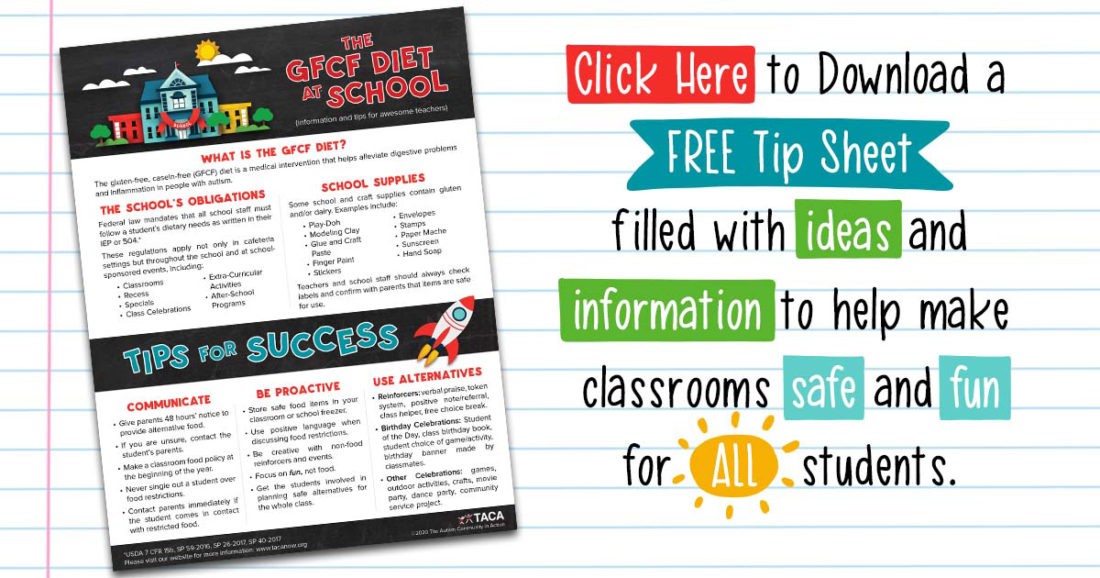The GFCF Diet at School: Information for Awesome Teachers

All contents of this resource were created for informational purposes only and are not intended to be a substitute for professional advice, diagnosis, or treatment. Always seek the advice of your physician, therapist, or other qualified health providers with any questions or concerns you may have.
If you have a student in your class who is on a GFCF diet, you may have questions and concerns. TACA is here to help. In this article, you will find:
- Answers to frequently asked questions.
- Ideas to help make this school year safe and fun for all of your students.
- A FREE, downloadable Tip Sheet with information for awesome teachers, like you!
What is the Gluten-Free, Casein-Free (GFCF) Diet?
The GFCF diet is a medical intervention used to alleviate digestive problems and inflammation in people with autism.
How Does the GFCF Diet Help?
Research shows that a GFCF diet can help alleviate some autism symptoms by improving gastrointestinal issues. Studies show a decrease in GI problems and behavioral issues while increasing cognition, communication, social skills, and nonverbal IQ.
What are the School’s Obligations to Students on a GFCF Diet?
Federal law mandates that all school staff must follow a student’s dietary needs as written in their IEP or 504. These regulations apply not only in cafeteria settings but throughout the school and at school-sponsored events, including:
- Classrooms
- Recess
- Specials
- Class Celebrations
- Extra-Curricular Activities
- After-School Programs
Generally, parents provide GFCF supplies for their child to use in the classroom and any snacks or special treats. Teachers and aides must ensure that the child uses only the GFCF supplies provided and that food is not shared during snack or lunchtimes.
Parents may provide lunches or request that the school cafeteria prepare and serve them. Federal laws and regulations require public schools to provide meal modifications through the cafeteria service, at no additional cost, to children whose disability restricts their diet. This includes children with autism on special diets due to food allergies, sensitivities, or sensory issues.
What About Non-Food Items Like Play-Doh and Other School Supplies?
There is some debate as to whether gluten molecules can be absorbed through the skin. However, there is no doubt that younger children will put their hands in their mouth or even eat Play-Doh. And, since even the tiniest amount of a restricted food can cause a reaction in some children, school staff should do their best to reduce the risk of exposure to them.
To reduce the risk of exposure, it helps be aware of school and craft supplies that may contain gluten/casein in them, such as:
- Play-Doh
- Modeling Clay
- Glue
- Craft Paste
- Finger Paint
- Stickers
- Envelopes
- Stamps
- Paper Mache
- Sunscreen
- Hand Soap
Teachers and school staff should always check labels and confirm with parents that items are safe for use. However, the easiest and safest way to help prevent accidental exposure via school or craft supplies is to provide parents with a list of items needed and only use products sent from home.
For example, if you plan on doing a craft that involves pasta, make sure that the parent supplies you with rice or corn pasta in the necessary shapes and quantities. Because many GFCF items can only be purchased in specialty stores or online, please give parents plenty of notice to obtain the needed items.
What Can I Do to Support a Student on a GFCF Diet in My Classroom?
- First and foremost, communicate with parents.
- Give them 48 hours’ notice to bring in replacement foods for events or activities.
- Most importantly, contact them immediately if their child has come in contact with a restricted food.
- Make a classroom food policy and give it to all class parents.
- Use positive language when discussing food restrictions.
- Above all, never single out a student over food restrictions.
- Read labels on foods, school supplies, and craft items used in your classroom.
- When in doubt, contact the parents.
- Store safe food alternatives in your class or school freezer.
- Be creative with non-food reinforcers and celebrations.
- See ideas below and/or involve your students in finding safe alternatives for the whole class.
What are Some Alternatives to Food-Based Reinforcers and Activities?
Reinforcers:
- Verbal praise
- Token system
- Positive note/referral
- Class helper
- Free choice break
Birthday Parties:
- Student of the Day
- Class birthday book
- Student choice of game or activity
- Class makes birthday student a personalized card or banner
- Celebrate all birthdays for the month on one day
Other Celebrations:
- Games
- Outdoor activities
- Crafts
- Movie party
- Dance party
- Community service project
Conclusion
While it may seem like a challenge at first, with cooperation and knowledge, maintaining a safe learning environment for students with food allergies is possible. Most importantly, it is critical to keep the lines of communication open. When parents and school staff work together, all students have an opportunity to thrive.
Additional Resources

Further Reading
- Tips for Including Dietary Restrictions in an IEP
- Must Schools Provide Meal Modifications for Students on Special Diets?




